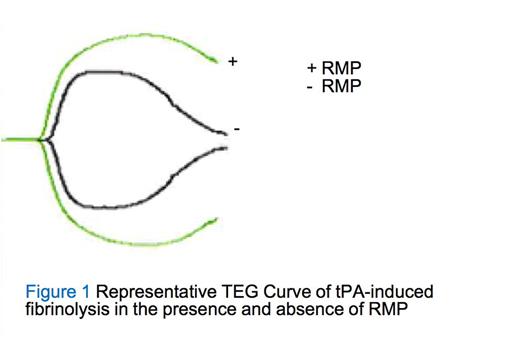Abstract
BACKGROUND. RMP have been developed as novel hemostatic agents for treatment of bleeding disorders [Thromb Haemost 110:751,2013]. RMP generate thrombin in vitro through activation of contact pathway independent of tissue factor. They correct coagulopathy associated with most factor deficient plasma, indicating promotion of secondary hemostasis. In addition, they promote primary hemostasis by enhancing platelet adhesion and aggregation. Recent literature suggests that excessive levels of tPA are responsible for the uncontrollable bleeding seen in trauma-related coagulopathies [J Trauma and Acute Care Surg 80:1,2016]. In this study, we used thromboelastography (TEG) to investigate the effects of RMP on tPA, a relation hitherto unexplored.
METHODS. The RMP were made by high-pressure extrusion of washed red cells. TEG was used to assess coagulation and fibrinolysis in fresh whole blood (diluted to 80%) in presence vs. absence of RMP (2.78x107/mL final conc. based on flow cytometry of PE-labeled mAb to CD235a). To hasten fibrinolysis for ease of measurement, tPA was added in all runs at final conc. 0.4 ug/mL. Calcium chloride (0.2 M) was added to each trial to induce coagulation. Additions to cup were: 325 uL of 80% blood + 10 uL tPA + 10 uL saline or RMP + 20 uL CaCl2. The tPA was stored in 50% glycerol at -20°C.
RESULTS. Representative TEG curves of tPA-induced fibrinolysis in the presence or absence of RMP are shown in Figure 1 below. In the presence of tPA without RMP, the MA is small and the amplitude will decline to the baseline in 30 - 60 min, reflecting ongoing fibrinolysis. The MA was increased by about 50% by addition of RMP, from 25mm to 37mm (p=0.016). Judging from fibrinolysis measured by the-built-in LY30 parameter (% lysed at 30 min after MA was achieved), the mean of n=6 paired t-tests was 61.3% lysed in absence of RMP vs. 36.3% with RMP, indicating 40% inhibition of fibrinolysis (p=0.046).
To assess the overall anti-fibrinolytic effect of RMP, we used the integral of the 1st derivative of the TEG curve, called TG (thrombus generation), which amounts to the total or net hemostatic-like activity. By this measure, addition of RMP gave TG = 457 vs. 319mm/min in absence of RMP (p=0.0044 by paired t test, P=0.037 by unpaired t test).
DISCUSSION. These findings suggest that RMP exert significant anti-fibrinolytic activity, enhancing its hemostatic activity. Uncontrollable bleeding due to fibrinolysis is a major component of many bleeding disorders, including acute coagulopathy of trauma which is seen in about 20% of cases and is associated with poor outcome. The mechanistic basis of this activity is not fully understood. It was suggested that RMP are incorporated into the fibrin network to consolidate its structure thus stabilizing the network and impeding fibrinolysis. Full exploration of this activity is warranted since treatment for excessive fibrinolysis would have great impact in clinical management of many bleeding disorders.
No relevant conflicts of interest to declare.
Author notes
Asterisk with author names denotes non-ASH members.


This feature is available to Subscribers Only
Sign In or Create an Account Close Modal